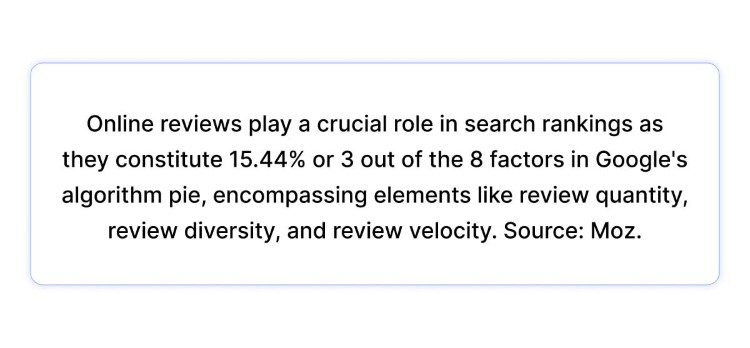In the present era, customers have numerous avenues to express their sentiments regarding your business. Ideally, you might receive a stellar five-star review on platforms such as Yelp or Google. However, there’s another side to it as well: a dissatisfied customer may criticize your company on the internet. When faced with a negative review of your business, the instinct may be to downplay it or engage in a counterattack. Yet, these reactions will not help you to win the game anyway. In reality, they can escalate a single negative review into a more significant issue.
Even if your business is performing exceptionally well, it’s inevitable that negative reviews will arise at some point. Addressing these reviews not only aids in problem resolution but also fosters customer loyalty, showcasing to potential clients the high standard of your customer service.
Acquiring the ability to effectively respond to negative reviews is an important skill for every business owner and customer service manager. Not dealing with bad reviews properly can make people think negatively about your brand and harm your ability to build a successful business.
In this read, we’ll explore some useful tips on how to personally respond to bad reviews. Plus, you’ll find real-life examples and templates for responding to negative reviews – practical tools you can put into action today.
What is the Typical Reaction to Negative Feedback?
When we encounter negative feedback, our initial response tends to be defensive or in denial. It’s a natural reaction that can take different forms—dismissing the feedback as unimportant, getting into arguments, or, unfortunately, even becoming aggressive towards the person sharing their thoughts.
This reaction is not rare because it aligns with our natural human instincts. Accepting negative feedback can be challenging, and if not approached with care, it’s easy to perceive it as a personal attack on our capabilities. It’s only natural to feel a desire to shield both yourself and your brand from any form of public criticism.
Yet, responding in this manner to negative reviews can harm your brand. It has the potential to foster resentment and may result in additional negative feedback down the line.
A more constructive approach to negative feedback involves adopting a receptive and open mindset. Rather than reacting defensively, strive to comprehend the customer’s perspective and the specific concerns they are highlighting.
Firstly, let’s discuss the typical reactions many companies have to negative reviews and why these responses may not be the most effective approach.
The Impact of Negative Reviews on Business
Negative reviews can have a significant impact on your business, affecting its reputation, customer trust, and ultimately its bottom line. Here are some key ways in which negative reviews can impact:
-
Loss of Valuable Customers
Negative reviews can drive prospective customers away, given that 84% of individuals place as much trust in online reviews as they do in recommendations from their friends.
A study by Review Tracker revealed that a significant 94% of consumers opt not to support a business when confronted with negative reviews. On the flip side, if your business has a lot of negative reviews chances are high that your potential customers opt to seek products or services elsewhere.
-
Brand Reputation Damage
Negative reviews have the potential to harm a company’s brand reputation by allowing customers to broadcast their unfavorable experiences to a wider audience. This can result in decreased customer loyalty and brand reputation.
Most people typically post reviews primarily on platforms such as Google or social media channels like Facebook, making the information about your business publicly accessible. This can also give rise to negative word-of-mouth promotion, as customers may relay their adverse experiences to friends and family.
-
Impact on Search Rankings
Negative reviews can influence the search engine ranking of a business. Search engines, such as Google, take into account both the quality and quantity of online reviews as significant factors in their ranking algorithms. If a business has a higher number of negative reviews compared to positive ones, its search engine ranking may decline. This can pose challenges for potential customers seeking to find the business online.
Fortunately, negative reviews do not always result in adverse outcomes. In some instances, they contribute a touch of authenticity to your brand. An exclusively positive review profile can appear as fabricated social proof. Therefore, if your brand has a few negative reviews it’s also fine as it tends to enhance trust in your brand.
A rating close to perfection or a flawless 5.0 is often deemed “too good to be true” and is met with skepticism. In fact, 82% of shoppers actively seek out negative reviews for a more balanced perspective.
Why Responding to Negative Reviews is So Important?
We’ve seen how bad negative reviews can be for a business. So, it’s smart to always be prepared with a strategy to respond to them. But guess what? Dealing with negative reviews isn’t just about damage control—it can also bring some good stuff!
Responding to negative reviews is like turning a challenge into a triumph for businesses. It’s not just about tackling criticism; it’s a chance to showcase your commitment to customer happiness and demonstrate that your brand is resilient and responsive. By engaging with dissatisfied customers openly and honestly, you not only diffuse potential negativity but also turn the spotlight on your brand’s dedication to customer satisfaction.
What to Do When You Get a Negative Review
Getting hit with a negative review can feel like a curveball, but don’t panic! Take a moment, read the review carefully, and resist the urge to hit back. Instead, put on your empathy hat and respond with genuine concern. Apologize sincerely, address the issue head-on, and if possible, toss in a sprinkle of solution. Let your customers know you’re on it! And here’s the secret sauce: invite them to chat offline to sort things out privately. Remember, it’s not just about fixing one problem: it’s about showing the world your dedication to making things right!
So how can You respond to such negative reviews? We will discuss it in the next section with expert tips, strategies and examples and replying to bad customer reviews.
How to Respond to Negative Reviews: Tips & Examples
Responding to negative feedback from dissatisfied customers is an essential practice now —it brings too many benefits for your business to ignore. Turning a blind eye only amplifies the impact of negative comments. Having a well-defined strategy for addressing unfavorable reviews simplifies the process, offering guidance on navigating what can be a challenging situation.
It personalizes the approach enabling your team to consistently connect with customers, even when facing a high volume of reviews. Here are some personalized best practices that you can follow as examples of negative or 1-star customer reviews.
1. Don’t Take It Personally
Although the reviewer may have expressed their sentiments with apparent emotion, it is advisable to regulate your own emotions and uphold a professional demeanor. This helps prevent the situation from escalating into a heated argument, as engaging in disputes is not at all good for your brand.
What does it mean? Just don’t take it personally. Chances are, the reviewer perceives the business as an impersonal entity, overlooking the real man behind the scenes. Resist getting weighed down by the negative feedback; instead, view it as a chance to glean insights, attentively listen, and enhance your relationship with clients.
Pro Tips:
- Pause for a bit and compose your thoughts before crafting a response.
- Avoid giving in to emotional reactions when faced with negative comments.
- See negative reviews as chances for growth and consider them as valuable feedback for your business.
- Express empathy in your response by recognizing the customer’s concerns and showing understanding of their point of view.
- If negative reviews are impacting you on a personal level, reach out to colleagues or supervisors for support.
2. Prompt Responses Matter
We exist in a world where instant gratification is the norm, with features like same-day delivery and round-the-clock assistance. Customers want swift responses from your company’s support agents, regardless of when the interaction was initiated. To align with both the reviewer’s expectations and those of potential customers perusing your reviews, it’s important to respond to comments promptly.
Demonstrating an attentive customer service team and a sincere interest in customer feedback and responding promptly to negative comments are the two most important things to keep in mind. The quicker you provide a reputation-enhancing response, the more beneficial it is. Avoid letting negative comments linger unresolved, as this could potentially discourage new customers.
Your Tips:
- Activate notifications for reviews across platforms to stay updated on new feedback.
- Establish specific response time objectives such as addressing reviews within 1-2 hours.
- Recognize and give priority to negative reviews demanding urgent attention.
- Explore using automation tools, such as live chat or chatbots, for timely alerts and efficient real-time assistance.
- Employ a review management system to streamline and organize your responses, enhancing overall efficiency.
- Regularly review and revise your response procedures to maintain their effectiveness and alignment with your business objectives.
3. Customize Your Reply
Generic copy-and-paste responses won’t suffice. If you aim to win back dissatisfied customers and convince potential ones that your response is genuine, following a strategy or template is fine—just ensure that you customize your reply to the specific review.
Begin by incorporating the customer’s name to create a more personalized message for him. Acknowledge the specific details they mentioned in their review to demonstrate that you’ve carefully read and considered their feedback. Communicate any actionable changes that you are going to take to avoid such mistakes in the near future. Personalization adds credibility, which is crucial for recovering from negative feedback.
Pro Tips:
- Start your response by using the customer’s name for a more personalized touch.
- Point out the specific concerns raised in the review to demonstrate a thorough understanding of their feedback.
- Create a response that is specifically crafted for the individual review.
- Infuse a friendly and conversational tone into your reply.
- Consistently use the customer’s name throughout your response to uphold a personal connection.
- Transparently acknowledge any mistakes or shortcomings and communicate openly about the actions being taken to address the concerns.
- Invite the customer to contact you privately for a more detailed discussion if necessary.
4. Express Gratitude and Apologize
Expressing gratitude for the customer’s thoughtful review goes a long way. Acknowledge their effort in bringing faults to your attention, turning it into an opportunity for improvement. Extend sincere apologies for their less-than-ideal experience. Demonstrating respect and politeness in response to any unfavorable comments showcases a high level of professionalism on your part.
Not everyone is ready to write words like “My apology.” The fact that your business is willing to express gratitude for negative reviews and offer apologies for any inconvenience or dissatisfaction speaks volumes about its character.
Pro Tips:
- Initiate your response by showing appreciation for the customer’s feedback.
- Avoid making excuses or assigning blame. Take ownership of any shortcomings, even if the issue was not entirely within your control.
- Present your apology in a positive light. Concentrate on the actions being taken to rectify the issue rather than emphasizing the negative aspects.
- Customize your apology to align with the specific details outlined in the review.
- Wrap up your response in a positive tone. Express gratitude once more for the customer’s feedback and convey your optimism about the chance to rebuild his trust.
5. Avoid Arguments
Don’t make things worse by arguing or getting defensive in your replies. Given that a high standard of customer service is a significant purchasing factor in today’s consumer landscape. Avoid letting negative things slide online, where it could potentially form the initial impression for prospective customers.
Show respect for the customer and the experience he has shared. Don’t shy away from admitting fault; it can significantly boost your online reputation compared to ignoring issues. Focus your response on solutions rather than debating the problem itself. Make an effort to rectify the situation. This is your best chance at resolving the issue; arguing about their feedback won’t improve anything.
Pro Tips:
- Refrain from reacting hastily in the midst of strong emotions.
- Avoid using defensive language or confrontational tones; instead, concentrate on discovering common ground for addressing the issue.
- Acknowledge positive aspects of the customer’s experience or any favorable feedback they shared, if relevant.
- If a review gets too argumentative, it’s okay to step back. Keep in mind that going on may not help, and it’s fine to focus on keeping a positive online image.
6. Provide Direct Communication Options for Customers
Transitioning the discussion to your company’s messaging platform or a phone call is often the best course of action for certain interactions. This not only reflects positively on your commitment to resolving issues and assisting dissatisfied customers but also enables you to collect additional personal info—such as contacts or order details—that shouldn’t be shared publicly.
A key element in converting dissatisfied customers into loyal ones is the act of genuinely listening to their concerns. Even if a mistake occurs, taking proactive steps to rectify the situation and make amends can transform a customer into a devoted fan. The importance of active and attentive listening should not be neglected.
Pro Tips:
- Encourage customers to use direct messages for private and detailed discussions.
- If suitable, share a contact phone number to indicate your readiness to resolve issues through direct communication.
- If your business offers a live chat feature, prompt customers to utilize it for immediate assistance.
- Ensure customers that you are accessible and eager to promptly address their concerns through direct communication channels.
- Verify that the communication channels provided are accessible and monitored, ensuring timely responses to customer inquiries.
Crafting Effective Responses: Examples for Handling Negative Reviews
Explore these response examples of negative feedback to adeptly manage challenging scenarios. Whether you opt for ready-to-use templates or choose to tailor your responses to fit the unique circumstances of each negative review, these bad review response examples provide a helpful starting point.
Under each template for negative feedback response, we will provide suggestions for subsequent actions to address the issue. Consider these as adaptable recommendations rather than strict rules, allowing you to tailor your approach based on the specific context.
Suggestion: Save this page for future reference and return to check these sample responses to negative comments whenever you need to craft replies to bad customer reviews.
1. On the Quality of Product Offerings
So, here’s an example of how to respond to a negative review. Now some tips for you!
- Initiate compensation or provide a discount to that customer.
- Follow up in a week to ensure that the customer is satisfied.
2. Customer Support
What to do next?
- Reach out to the customer and attentively address his concerns.
- Implement modifications to enhance the overall customer experience if necessary.
- Follow up with the customer to inform him about the adjustments that have been implemented.
3. About Product Pricing
What to do next?
- If the mistake originates from our side, extend a refund.
- Modify billing policies as needed to avoid future confusion.
4. Shipping and Product Delivery
What to do next?
- Share a discount or coupon code.
- Follow up with the carrier company to confirm the package’s delivery.
- Reach out to the customer to ensure receipt.
5. Cancellation Issues
What to do next?
- In the event of an error, extend a refund or store credit.
- Revise written policies as needed.
6. Long Waiting Time
What to do next?
- Follow up to confirm the resolution of the customer’s issue.
- If feasible, plan to increase your customer support resources.
- Modify your business phone system to announce the anticipated waiting time for customers.
7. Technical Problems
What to do next?
- If there is a technical problem, promptly relay the feedback to the technical team for faster resolution.
- Subsequently, get in touch with the customer to confirm that the issue has been resolved.
8. Overall Experience
What to do next?
- Provide the customer with a discount, or a complimentary item.
- If the review highlights valid areas for improvement, take proactive steps to address those.
9. Website Usability
What to do next?
- If there is a technical problem, promptly forward the concern to the technical team for faster resolution.
- Create and update additional product tutorials.
10. On Customization of Products
What to do next?
- Ensure a prompt follow-up with the customer.
- If there is substantial demand for personalization, contemplate providing it as an additional service.
Wrapping Up!
Let’s face it. Receiving negative reviews is disheartening.
But HOLD ON! As long as you respond promptly, tactfully, and follow up, you can turn negative reviews into a positive opportunity for your business. If you can transform the author of the bad review into a devoted customer, you will gain powerful social proof in favor of your company.
It’s essential to highlight that relying solely on online reviews for social proof isn’t your only option. You have various alternatives to consider. Leveraging social proof to enhance conversions can be achieved through great customer assistance.
Turn to REVE Chat for assistance. This omnichannel customer engagement platform enables you to provide instant support on your website, mobile app, and various social media platforms. It also helps you to collect real-time reviews and reply to customer complaints on various platforms instantly.
REVE Chatbot automates several business operations, including customer service, allowing you to extend services even outside regular business hours.
Keen to try it out? Sign Up for the 14-day FREE TRIAL today!
















